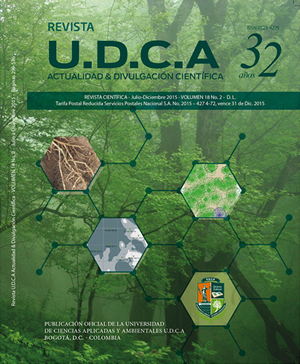Potencial mutagénico y genotóxico de aguas residuales de la curtiembre Tasajero en la ciudad de Cúcuta, Norte de Santander, Colombia
Mutagenic and genotoxic potential of waste water from the tannery Tasajero, Cucuta, North Santander, Colombia
Contenido principal del artículo
Resumen
La curtición es un proceso industrial que requiere grandes volúmenes de agua para la transformación de un material putrescible en uno imputrescible, apto para su utilización, en productos manufacturados. Las aguas residuales generadas por dicha industria, generalmente, son vertidas a los cuerpos de agua sin tratamiento previo, generando así grandes cantidades de demandas bioquímicas de oxígeno y química de oxígeno, valores elevados de pH, presencia de sustancias químicas tóxicas, que actúan como mutágenos, aumentando así el riesgo de desarrollar cáncer en la población expuesta. En la ciudad de Cúcuta, se encuentran pequeñas industrias de curtiembres, que no poseen las herramientas básicas, ni conocimientos sobre el adecuado tratamiento de los residuos, generando contaminación en el recurso hídrico, que luego puede llegar a ser usado por la población. En los procesos químicos de esta industria, se usan el cromo, el plomo, los sulfuros, los cromatos de zinc y el calcio, compuestos considerados, entre los carcinógenos humanos, más potentes. El estudio contempló el análisis y la determinación de la mutagenicidad y genotoxicidad en aguas residuales de la curtiembre Tasajero. Para la determinación de la genotoxicidad, se usó el ensayo cometa y para el análisis de la mutagenicidad, se aplicó el test de Ames, con las cepas de Salmonella typhimurium TA98 y TA100. Se encontró que las aguas de desecho de la curtiembre Tasajero inducen daño al ADN en linfocitos humanos; de igual manera, se halló que estas aguas también inducen un incremento en la mutagenicidad en la cepa TA98.
Palabras clave:
Descargas
Datos de publicación
Perfil evaluadores/as N/D
Declaraciones de autoría
- Sociedad académica
- Universidad de Ciencias Aplicadas UDCA
- Editorial
- Universidad de Ciencias Aplicadas y Ambientales U.D.C.A
Detalles del artículo
Referencias (VER)
ACHARYA, S.; MEHTA, K.; KRISHNAN, S.; RAO, C.V. 2001. A subtoxic interactive toxicity study of ethanol and chromium in male Wistar rats. Alcohol. 23:99- 108.
AGENCY FOR TOXIC SUBSTANCES and DISEASE REGISTRY (ATSDR). 2000. Toxicological profile for Polychlorinated Biphenyls (PCBs). p.1-92.
ALBERG, A.J.; SAMET, J.M. 2003. Epidemiology of lung cancer. Chest. 123(1 Suppl):21S-49S.
ÁLVAREZ–BERNAL, D.; CONTRERAS-RAMOS, S.M.; TRUJILLO-TAPIA, N.; OLALDE-PORTUGAL, V.; FRIAS-HERNANDEZ, J.T.; DENDOOVEN, L. 2006. Effects of tanneries wastewater on chemical and biological soil characteristics. Appl. Soil Ecology. 33:269-277.
AMES, B.N.; LEE, F.D.; DURSTON, W.E. 1973. An improved bacterial test system for the detection and classification of mutagens and carcinogens. Proc. Nal. Acad. Sci. (USA). 70(3):782-786.
AMES, B.N.; McCANN, J.; YAMASSAKI, E. 1975. Methods for detecting carcinogens and matagens with the Salmonella/mammalian microsmes muagenicity test. Mut. Res. 31:347-364
CASTLEMAN, B. 1995. Bayer, Dow: Migración de riesgos industriales. Rev. del Sur, Octubre 1995. Disponible desde Internet en: http://www.cbgnetwork.org/925. html (con acceso 18/10/14)
CERYAK, S.; ZINGARIELLO, C.; O’BRIEN, T.; PATIERNO, S.T. 2004. Induction of pro-apoptotic and cell cycle-inhibiting genes in chromium (VI)-treated human lung fibroblasts: lack of effect of ERK. Mol. Cell. Biochem. 255:139-149.
CHÁVEZ PORRAS, A. 2010. Descripción de la nocividad del cromo proveniente de la industria curtiembre y de las posibles formas de removerlo. Rev. Ingenierías. (Colombia). 9(17):41-49.
Di IACONI, C.; Di PINTO, A.C.; RICCO, G.; TOMEI, M.C. 2002. Treatment options for tannery wastewater II: integrated chemical and biological oxidation. Ann. Chim. 92(5-6):531-539.
DHAYALAN, K.; FATHIMA, N.N.; GNANAMANI, A.; RAO, J.R.; NAIR, B.U.; RAMASAMI, T. 2007. Biodegradability of leathers through anaerobic pathway. Waste Managem. 27(6):760-767.
DOTRO, G.; CASTRO, S.; TUJCHNEIDER, O.; PIOVANO, N.; PARIS, M.; FAQQI, A.; PALAZOLO, P.; LARSEN, D.; FITCH, M. 2012. Performance of pilot-scale constructed wetlands for secondary treatment of chromium-bearing tannery wastewaters. J. Hazard Mater. 239-240:142-151.
De FLORA, S. 2000. Threshold mechanisms and site specificity in chromium (VI) carcinogenesis. Carcinogenesis. 21:533-541.
EUROPEAN COMISSION. 2001. European ComissionDirectorate-General for Environment. Survey on Wastes Spread on Land-Final Report. Study contract B4-3040/99/110194/MAR/E3. ISBN 92-894-1732-3. p.1-109.
HOLMES, A.L.; WISE, S.S.; WISE, J.P. 2008. Carcinogenicity of hexavalent chromium. Indian J. Med. Res. 128:353-372. 16. JENNETTE, K.W. 1982. Microsomal reduction of the carcinogen chromate produces chromium (V). J. Am. Chem. Soc. 104(3):874-875.
KRISTEN, P.; NICKENS, A.; ATIERNO, S.R.; CERYAK, S. 2010. Chromium genotoxicity: A double-edged sword. Chemico-Biological Interactions.188:276-288.
JENNETTE, K.W. 1982. Microsomal reduction of the carcinogen chromate produces chromium (V). J. Am. Chem. Soc. 104(3):874-875.
LOFRANO, G.; MERIC, S.; ZENGIN, G.E.; ORHON, D. 2013. Chemical and biological treatment technologies for leather tannery chemicals and wastewaters: a review. Sci. Total Environ. 461-462:265-281.
MARON, D.M.; AMES, B.N. 1973. Revised methods for the salmonella mutagenicity test. Mutat. Res. 113(3- 4):173-215.
NATIONAL TOXICOLOGY PROGRAM. 2005. NTP 11th Report on Carcinogens. Rep. Carcinog. 11:1-A32.
O’BRIEN, T.; XU, J.; PATIERNO, S.R. 2001. Effects of glutathione on chromium-induced DNA crosslinking and DNA polymerase arrest. Mol. Cell. Biochem. 222:173-182.
O’BRIEN, T.J.; CERYAK, S.; PATIERNO, S.R. 2003. Complexities of chromium carcinogenesis: role of cellular response, repair and recovery mechanisms. Mutat. Res. 533:3-36.
O’BRIEN, T.J.; WITCHER, P.; BROOKS, B.; PATIERNO, S.R. 2009. DNA polymerase zeta is essential for hexavalent chromium-induced mutagenesis, Mutat. Res. 663:77-83.
PANDRANGI, R.; PETRAS, M.; RALPH, S.; VRZOC, M. 1995. Alkaline single cell gel (comet) ssay and genotoxicity monitoring using bulheads and carp. Environ. Mol. Mutagen. 26(4):345-35.
PLUNKETT, E.R. 1976. Handbook of Industrial Toxicology. Chemical Publishing, New York, NY. 536p.
SALNIKOW, K.; ZHITKOVICH, A. 2008. Genetic and epigenetic mechanisms in metal carcinogenesis and cocarcinogenesis: nickel, arsenic, and chromium. Chem. Res.Toxicol. 21:28-44.
SEDMAN, R.M.; BEAUMONT, J.; McDONALD, T.A.; REYNOLDS, S.; KROWECH, G.; HOWD, R. 2006. Review of the evidence regarding the carcinogenicity of hexavalent chromium in drinking water. J. Environ. Sci. Health. C. Environ. Carcinog. Ecotoxicol. Rev. 24:155-182.
SINGH, N.P.; McCOY, M.T.; TICE, R.R.; SCHNEIDER, E.L.1988. A simple technique for quantitation of low levels of DNA damage in individual cells. Exp. Cell Res. 75(1):184-91.
SHAKIR, L.; EJAZ, S.; QURESHI, N.A.; ANJUM, A.A.; IITAF, I.; JAVEED, A. 2012. Ecotoxicological risks associated with tannery effluent wastewater. Environ. l Toxicol. Pharmacol. 34(2):180-191.
SUGIYAMA, M.; TSUZUKI, K.; LIN, X.; COSTA, M. 1992. Potentiation of sodium Chromate (VI)-induced chromosomal aberrations and mutation by vitamin B2 in Chinese hamster V79 cells. Mutat. Res. 283:211- 214.
SUGIYAMA, M. 1991. Effects of vitamins on chromium (VI)-induced damage. Environ. Health Perspect. 92:63-70.
TAGLIARI, K.C.; CECCHINI, R.; ROCHA, J.A.V.; VARGAS, V.M.F. 2004. Mutagenicity of sediment and biomarkers of oxidative stress in fish from aquatic environments under the influence of tanneries. Mutat. Res. 561:101-117.
TÖRNQVIST, R.; JARSJO, J.; KARIMOV, B. 2011. Health risks from large-scale water pollution: trends in Central Asia. Environ. Int. 37(2):435-42.
THANIKAIVELAN, P.; RAO, J.R.; NAIR, B.U.; RAMASAMI, T. 2005. Recent trends in leather making: processes, problems, and pathways. Crit. Rev. Environ. Sci. Techn. 35(1):37-79.
U.S. ENVIRONMENTAL PROTECTION AGENCY. 1999. Integrated Risk Information System on Chromium (VI).p.17-29.
VARGAS, V.; MIGLIAVACCA, S.; MELO, A.; HORN, R. 2001. Genotoxicity assessment in aquatic environments under the influence of heavy metals and organic contaminants. Mut. Res. 490:141-158.
WISE, S.S.; SCHULER, J.H.; HOLMES, A.L.; KATSIFIS, S.P.; KETTERER, M.E.; HARTSOCK, W.J.; ZHENG, T.; WISE, J.P. Sr. 2004. Comparison of two particulate hexavalent chromium compounds: barium chromate is more genotoxic than lead chromate in human lung cells. Environ. Mol. Mutagen. 44:156-162.
WITSCHI, H.R.; PINKERTON, K.E.; VANWINKLE, L.S,; LAST, J.A. 2008. CASSARETT & DOULL’s. Toxicology: The basic science of poisons. chapter 15. Toxic responses of the respiratory system. 7th edition, ed. McGraw-Hill Inc. New York, NY. p.609-630.







